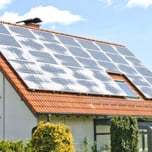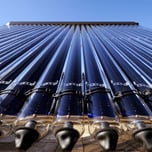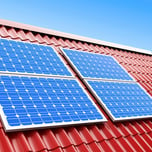
Get up to 4 quotes by filling in only 1 quick form

Slash your energy bills by installing solar panels

We’ve helped over 500,000 homeowners reduce their carbon footprint
- GreenMatch
- Solar Energy
- Solar PV
Solar PV
Why Is a Solar PV System a Great Option for Your Home?
Using solar energy will benefit you, your home, the environment, and the future generations to come. Solar energy is a versatile, renewable resource that can be utilised in many different ways. For instance, when producing electricity, heat, and warm water solutions.
The UK is one of the top 5 countries in Europe when it comes to the use of solar energy and installations of solar panels, and the use of green energy continues to grow. This should not come as a surprise because, since 2011, the UK has set an ambitious goal to supply 15% of the country’s energy demand from renewable resources (under the Renewable Energy Roadmap programme) by 2020.
Solar PV has been covered under the Feed-in Tariff in the UK. However, as solar panels have become more affordable, the government has decided to close the scheme as they are now much more affordable than they used to be. It has since been replaced by the Smart Export Guarantee (SEG).
Switching to a solar PV system for your home is a great investment in the UK, and there’s never been a better time to make the switch. Solar energy is an affordable and renewable energy source that can help you save on your electricity bills.
At GreenMatch, we can help you find the best solar panels in the UK by providing quotes from up to 3 reliable solar panel manufacturers. Don’t wait any longer to start enjoying the benefits of solar power for your home.
- Quotes from local engineers
- Payment by finance available
- Save up to £729 per year
It only takes 30 seconds



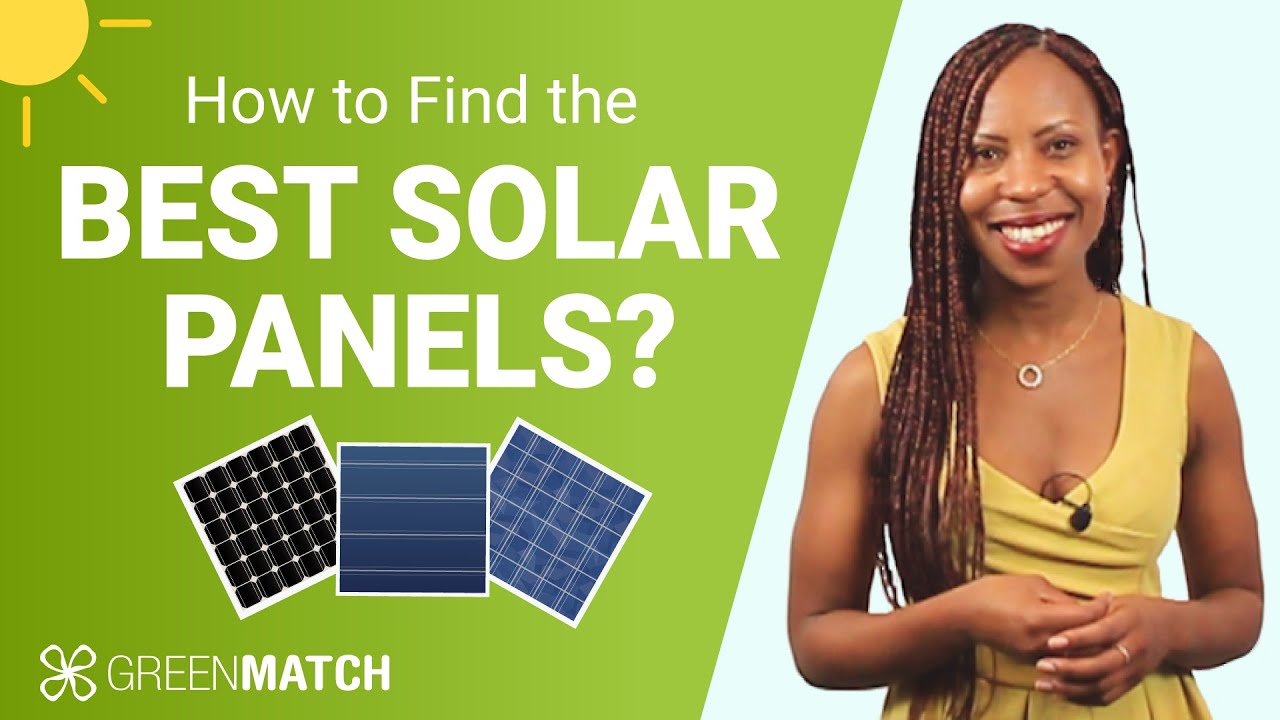
What Is Solar PV?
The conversion of solar power into usable electricity is an interesting process that takes place through the use of different systems and technologies. The most commonly used system for converting solar power is the Photovoltaic system, also known as ‘Solar PV’.
Solar PV converts the light from the sun directly into electricity using an array of solar panels. These solar PV panels consist of multiple solar cells that work together to convert the energy from the sun into ready-to-use electricity. Solar cells are typically very small, and each one is capable of producing a certain amount of electricity. However, combining them into a module of about 40 solar cells each, and assembling those into a solar PV array, solar PV panels have a much greater efficiency; enough to cover your entire household’s electricity needs.
Pros and Cons of Solar PV
Solar energy comes with many advantages and very few disadvantages. Most significant, and obvious advantage of using solar energy is that after investing in solar PV, your electricity costs could be greatly reduced.
ADVANTAGES
- Solar PV uses natural and renewable energy from the sun. Meaning that, solar power is inexhaustible and can not be over consumed.
- Solar energy is available everywhere. Hence, even though countries in the Earth’s Southern hemisphere have more potential because of the greater amount of sunny days each year, solar energy is not limited only to those areas. In fact, Northern countries are some of the biggest producers of solar energy in the world.
- Solar energy is free. Although the installation costs might be high, after you have the system installed, you will not be charged for the energy that you use from the system.
- Solar PV system increases the value and independence of your home.
- Solar PV arrays work even on cloudy days. The technology of Photovoltaic system is so advanced, that a Solar PV system is able to generate energy even on cloudy days.
It is almost impossible to point out to any drawbacks to Solar PV systems because of how functional and beneficial they are. Nevertheless, it is important to consider some things before you make a final decision.
DISADVANTAGES
- The initial cost and installation of a solar panel system is quite high. However, as new technologies emerge, the cost of Solar PV systems is likely to decrease, which will lead to increased demand and use of solar panels for generating electricity.
- They do not produce energy during the night-time hours. Hence, they are able to only produce power in the daytime, when the sun is out. However, this should not be a problem, if you have a Solar PV that is grid connected because that way you are able to store the extra energy produced during the day as a reserve and use it throughout the night, while your system is not producing any electricity. If you need hot water during the entire day and would like to convert to renewable energy, thermodynamic panels might be the solution for you.
How Much Will Solar PV Cost You?
The price of a solar panels will depend on many factors, and, therefore, it is impossible to estimate the exact price. Usually, the total price will depend on the size and condition of the roof, roof inclination, amount of electricity required, and the size of your home. However, it is important to note that because of the competition on the market and decreasing manufacturing costs, solar PV system has reduced in price by 70% over the past few years. Following a similar trend, solar panel batteries cost less than before while improving their capacity and lifetime.
Nonetheless, to give you an idea about the approximate average price, we have created the following table below.
| Approximate Roof Space (sq m) | Typical System Size (kW) | Estimated Cost (£) | CO2 saved over 20 years (tons) |
|---|---|---|---|
| 8 | 1 | 2,500-3,000 | 10 |
| 14 | 2 | 3,000-4,000 | 20 |
| 21 | 3 | 4,000-6,000 | 30 |
| 28 | 4 | 6,000-8,000 | 40 |
Keep in mind that the prices we list are only estimates based on industry averages, and to get a more accurate and specific price, you’ll need to get quotes from our trusted suppliers. But don’t worry, we make it simple to do so.
Complete our online form, and we’ll connect you with up to 3 reliable solar panel manufacturers near you who can provide you with tailored quotes based on your specific needs. Get started today and see how you can save money on your energy bills while helping the environment.
- Quotes from local engineers
- Payment by finance available
- Save up to £729 per year
It only takes 30 seconds



Optimise Your Energy Consumption with a Solar PV System That Fits Your Needs
The main classification of solar PV systems is related to their dependence on the electricity network (the grid). Hence, Solar PV systems can be classified into grid-connected and off-grid systems. Which one fit your situation the best, will depend on the area your house is located, and your electricity needs.
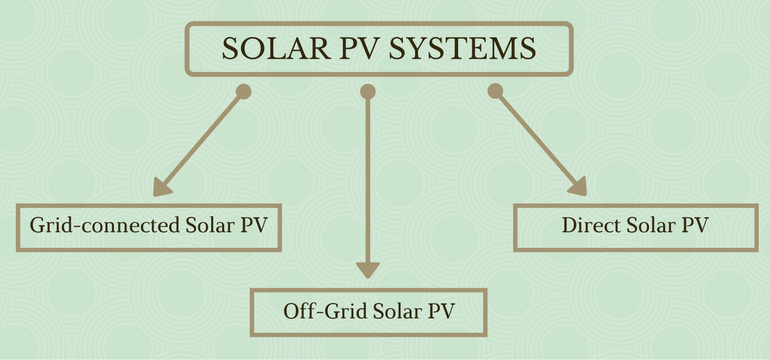
The first category is the most popular type of Solar PV and refers to those solar panel systems that are connected to the public grid, and, can, therefore, use electricity from an electricity provider while the panels are not producing power (at night). If your system is connected to the grid, you can sell the surplus electricity generated by your panels back to your energy supplier.
There are different solar panel system sizes, which one is best for you will depend on how big your property is and what your energy needs are.
- 1 kW Solar Panel System
- 2 kW Solar Panel System
- 3 kW Solar Panel System
- 4 kW Solar Panel System
- 5 kW Solar Panel System
- 6 kW Solar Panel System
- 12 kW Solar Panel System
The second type, hence the off-grid Solar PV, is also known as a ‘stand-alone system’ because it is not connected to the public grid. Such systems are well-suited for remote regions where there is no primary electricity source.
This type of Solar PV system is a convenient option since you will not need to acquire a special permit from the electricity companies. Usually, these systems can be more pricey, because they contain more component than the grid-connected version. For instance, since the extra energy cannot be sent back to the grid, you will need to have backup batteries to store the excess energy that is produced. They can be mounted both on the roof or on the ground.
Another Solar Photovoltaic system that can be used with certain devices at home, is called PV Direct. This is a very simple solar system that is connected directly to a pump or a motor, which match the voltage and amperage output of the solar panels. Thus, when the sun is out and the panels are able to produce electricity, the device will start running, and, on the contrary, when there is no direct sunlight, power is not produced and the device will be inactive.
Which Solar Panel Type Is the Best?
Apart from the varieties of Photovoltaic systems, the technologies that these systems use to produce electricity can be different, as well. The most popular solar PV technologies are Monocrystalline, Polycrystalline, and Thin Film.
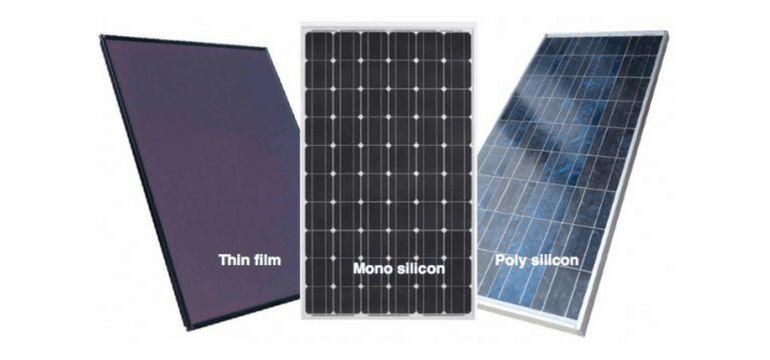
1. Monocrystalline solar cells: these cells are made of monocrystalline silicon (mono-Si) and are recognisable by their simple, uniform appearance and external colouring. These cells have the best efficiency rates because they are made out of the highest-grade silicon. Furthermore, they are space-efficient, and have the longest lifetime of all solar panel types.
2. Polycrystalline solar cells: these cells are also made from similar silicon, but, instead, are fused into a single crystal, as they are melted and poured into a mold. When it comes to the process of making these cells, less silicon is used, and thus, costs less to produce. What’s more, even the building process is cheaper, but their efficiency is much lower than the monocrystalline solar cells. Their lifespan is also shorter and heat can affect their performance in the long-term.
3. Thin Film solar cells (TFSC): these cells are made by depositing one or more thin layers (thin film) of photovoltaic material onto glass, plastic, or metal. They can be categorised by the material that is used to coat the substrate (Amorphous silicon, Cadmium telluride, copper indium gallium selenide, and organic photovoltaic cells). The main advantages of these solar panels are that they are cheaper to manufacture and their performance is not affected by high temperatures or shading. Furthermore, their appearance is more appealing than the crystalline solar cells.
How Does Solar PV Work to Produce the Maximum Electricity?
A Solar PV system is designed to gather the solar energy in the form of sunlight and turn it into direct current (DC) electricity. When the light hits the cell, electrons are released; these electrons form the direct current.
The direct current (DC) needs to be converted into alternating current (AC), that can be used for domestic building. The conversion is achieved through an inverter that is one of the main components of Solar PV system.
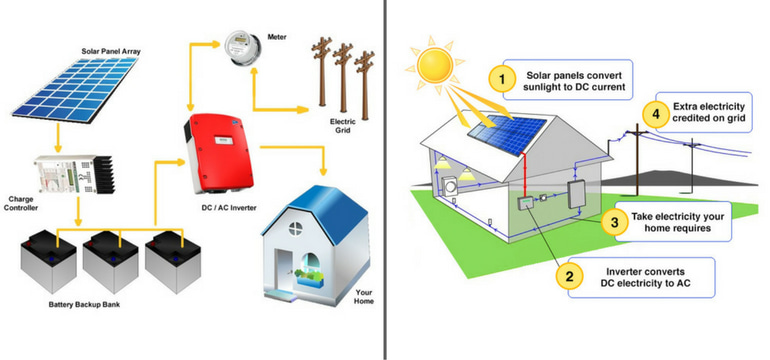
If you are interested in finding more information on solar panels regarding their installation or cost, just click the button below to fill in our 30-second form and we’ll make sure to provide you with quotes from up to 3 of our trusted suppliers. This way you will be able to save time on research and be able to make a quick and easy decision.
- Quotes from local engineers
- Payment by finance available
- Save up to £729 per year
It only takes 30 seconds




Valli has been writing well researched articles about renewable energy, sustainability and green technologies for GreenMatch since 2017. Her work has been published in various media such as Entrepreneur, Business Insider, Canadian Geographic, uSwitch, and eCycle.
 We strive to connect our customers with the right product and supplier. Would you like to be part of GreenMatch?
We strive to connect our customers with the right product and supplier. Would you like to be part of GreenMatch? 

